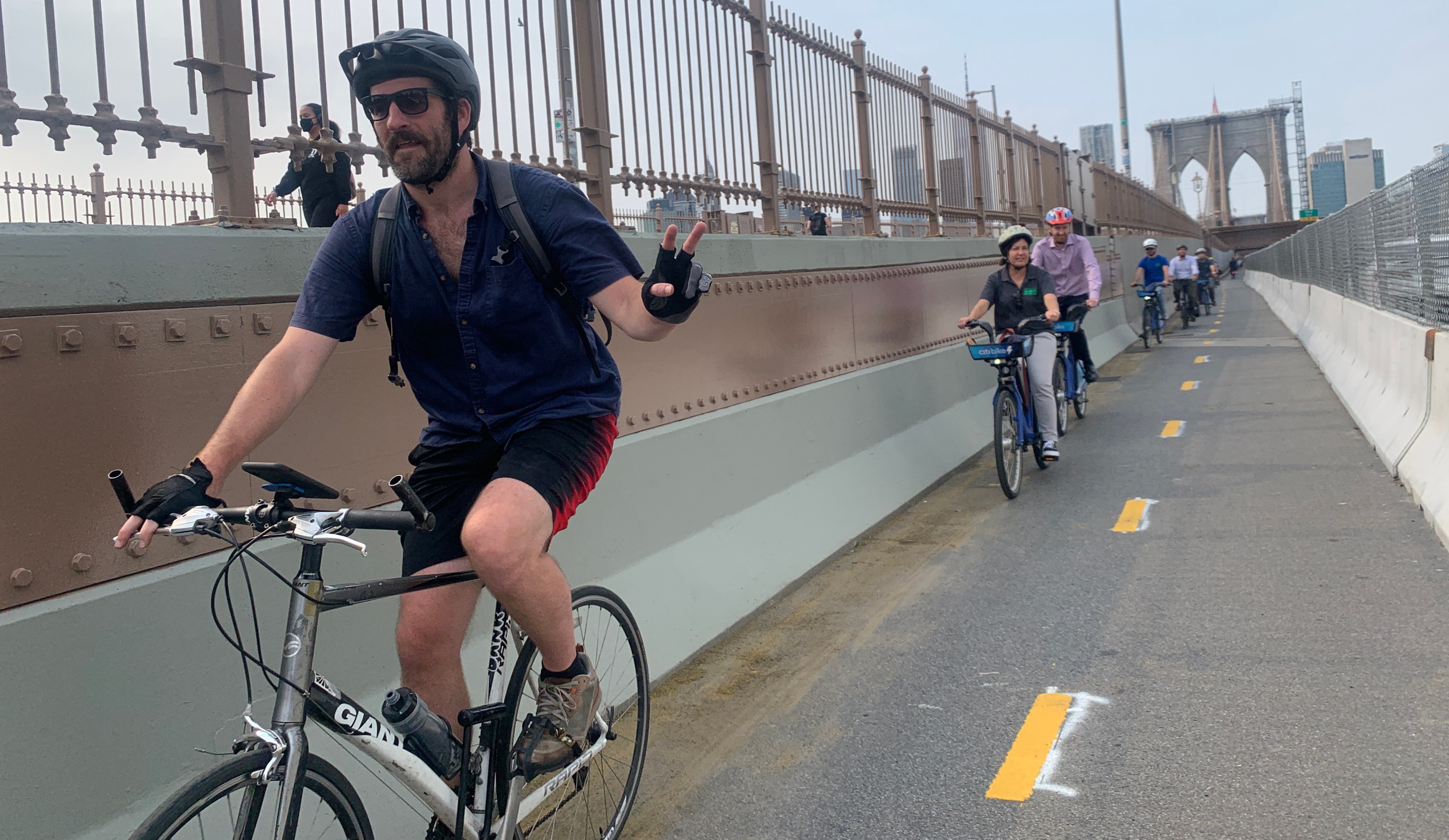This post originally appeared on PeopleForBikes and is reprinted here with permission.
From bustling cities to small towns, communities from coast to coast amplified their commitment to better biking with an unprecedented surge in safer, more comfortable places to ride in 2023. And, with thousands of additional projects planned across the country and more federal funding for bikes available than ever, we can reasonably expect the pace of construction to increase more dramatically in the coming years.
Even for the most ardent naysayers, it’s difficult to deny that the landscape of bicycling in America is transforming (although not as quickly as many of us would like to see). While we have yet to see any U.S. cities emerge with truly bold citywide plans for bike networks as we’ve seen in places like London, Paris, and Bogota, many are (slowly) beginning to envision a future where cycling takes center stage. Although there remains a substantial amount of work ahead of us to cultivate a safe and comfortable environment for people of all ages and abilities to ride bikes in the U.S., it’s well worth pausing to commemorate the significant infrastructure victories U.S. cities achieved in 2023.
1. Broadway | New York City
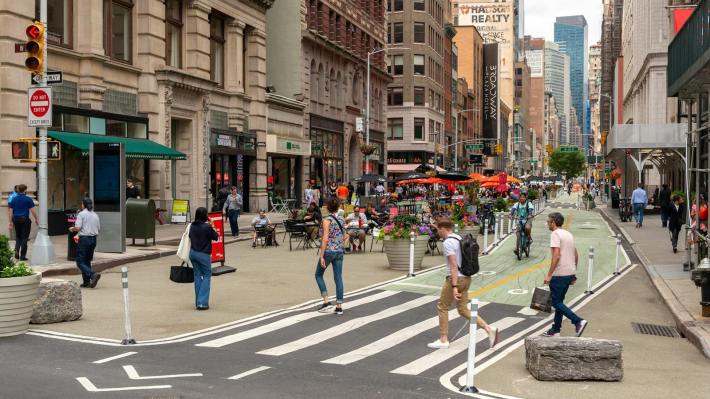
After car-free streets took the top spot on last year’s list, we’re delighted to witness locales like New York City continuing to adopt more of these low-stress environments for cyclists. Launched in March, NYC’s much-anticipated vision for Broadway is beginning to transform the iconic street with pedestrian plazas, inviting outdoor dining structures, planters, and bike improvements, with the stretch between West 25th and 32nd streets being reshaped in 2023. While the full vision includes a “people-centric” Broadway connecting Union Square to Columbus Circle, the city’s next phase is on the horizon, with planned improvements underway between West 33rd and 21st Street.
2. 156th Street Cycle Track | Redmond, Washington
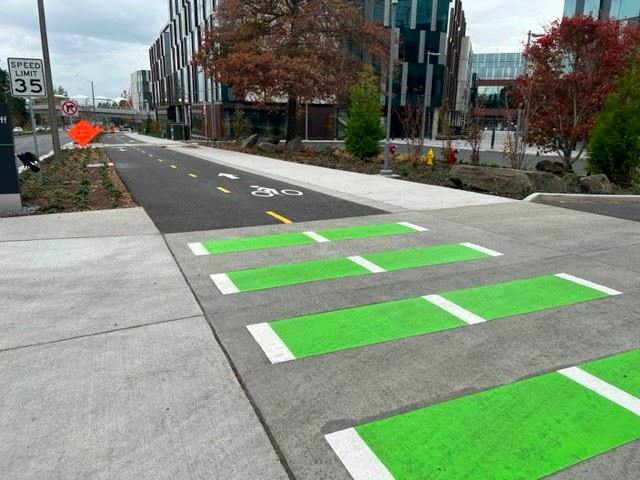
Featuring a two-way cycle track, Redmond’s 156th Street Cycle Track improves access to the Redmond Technology Station — part of Sound Transit’s East Link Extension — and the NE 40th Street Shared Use Path. This area of Redmond, the longstanding home of the Microsoft Corporate Campus, remains a focal point for the tech giant’s ongoing commitment to community development. While the Microsoft-funded section is complete, the City of Redmond is working to expand it further from 140th to Turing.
3. 300 West | Salt Lake City
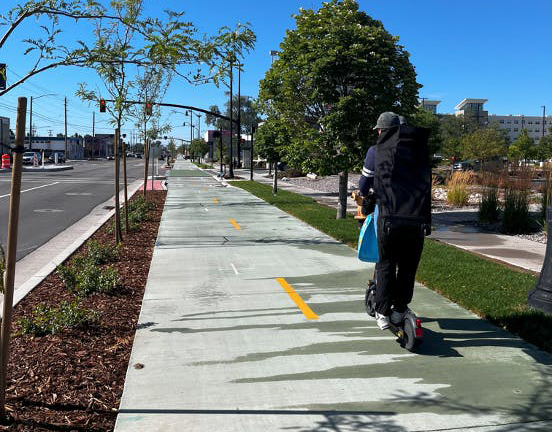
In September, Salt Lake City celebrated the completion of its most significant public works project to date, the 300 West Reconstruction Project, which features a separated, two-way, 10-foot-wide bike lane, upgraded sidewalks, and more than 200 new trees to provide shade and serve as a buffer to the roadway. New “bioswales” were also integrated to improve water quality by filtering debris from stormwater runoff. The project, funded through the “Funding Our Future” bond, showcases Salt Lake City’s commitment to prioritizing biking as a sustainable and accessible mode of transportation while fostering greener and safer corridors for all road users. Special project features include raised sidewalks and bikeways at all non-signalized intersections, bike counters, wayfinding signage, and green-tinted concrete.
4. Inman Square | Cambridge
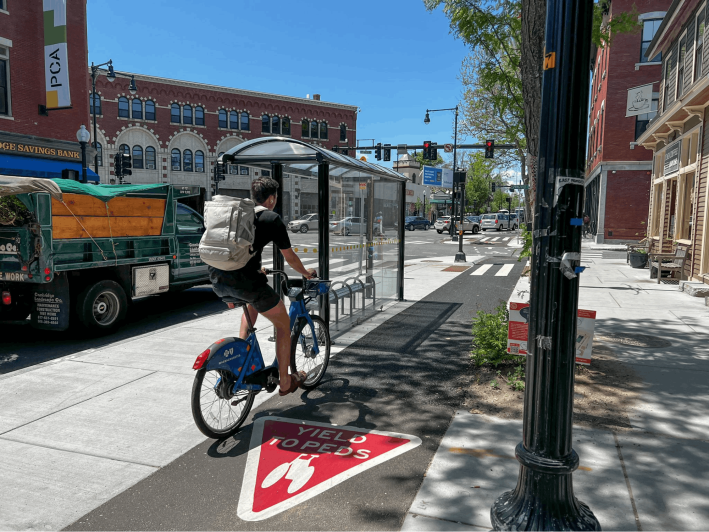
After two and a half years of construction, the Inman Square project in Cambridge reached its much-anticipated completion in 2023, featuring sidewalk-level bike lanes, protected intersections, shorter crosswalks, and a vibrant new plaza. Serving as a pivotal crossroads for various modes of transportation, these enhancements further Cambridge’s dedication to Vision Zero and demonstrate the power of their Cycling Safety Ordinance, which propelled Cambridge to a score of 58 in PeopleForBikes’ annual City Ratings program. As evidence of its high quality, the project made headlines earlier this year after a social media video seemingly showcasing bike infrastructure in the Netherlands went viral, only to be revealed as a playful deception filmed in Cambridge’s Inman Square.
5. Bryant Avenue South | Minneapolis, Minnesota
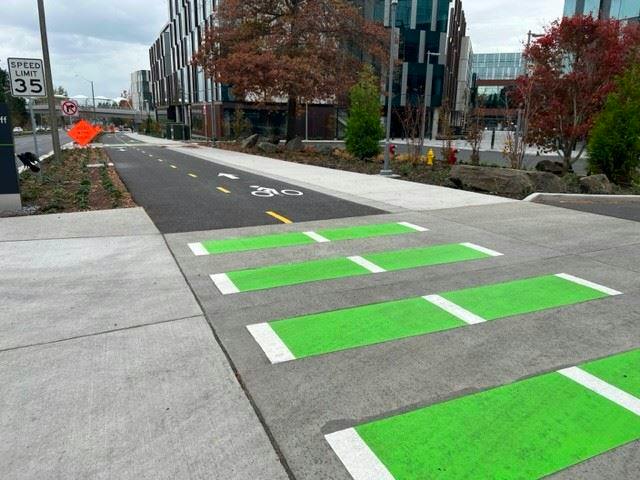
Minneapolis’s Bryant Avenue South reconstruction project, stretching from Lake St. to 50th St. W., reshaped a residential street in the heart of south Minneapolis. Despite its quiet residential character, Bryant Avenue is a key bicycling corridor parallel to the congested Lyndale Avenue. Previously converted into a “bicycle boulevard” in 2010, the reconstruction — which created a bidirectional sidewalk-level protected bikeway, intersection improvements, pedestrian-scale lighting, and stormwater infrastructure — reflects a forward-looking commitment to safer and more sustainable transportation that’s helped Minneapolis become the best large U.S. city this year’s City Ratings.
6. Union Street | Pasadena
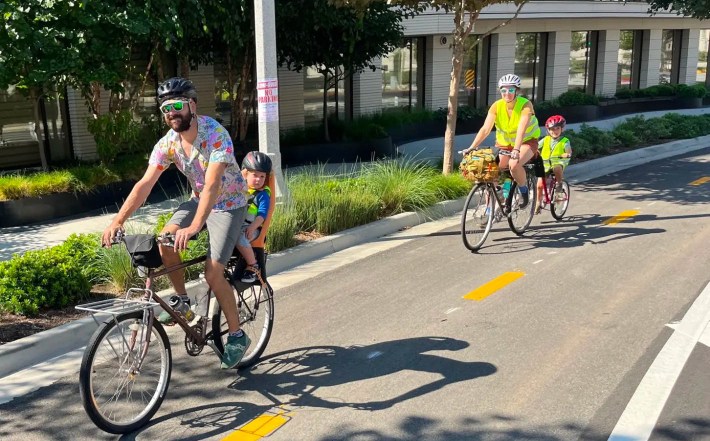
In September, Pasadena celebrated the completion of its first two-way protected bike lane along Union Street. The new 1.5-mile protected bike lane enhances connectivity to Pasadena’s popular destinations, including Old Pasadena, Playhouse Village, Pasadena City College, Caltech, and the Metro Gold Line Station at Memorial Park. Approved by the City Council in 2016, the project repurposed existing road space to accommodate the protected bike lane, converting the previous one-way westbound street into a cyclist-friendly corridor. This initiative supports Pasadena’s commitment to sustainable transportation and efficient urban planning. The project was funded through a combination of local and federal sources, including the American Rescue Plan Act, California’s Active Transportation Program, Gas Tax, Los Angeles County’s Measure R, CMAQ, and Pasadena’s Traffic Reduction Fee.
7. Baseline Road | Boulder
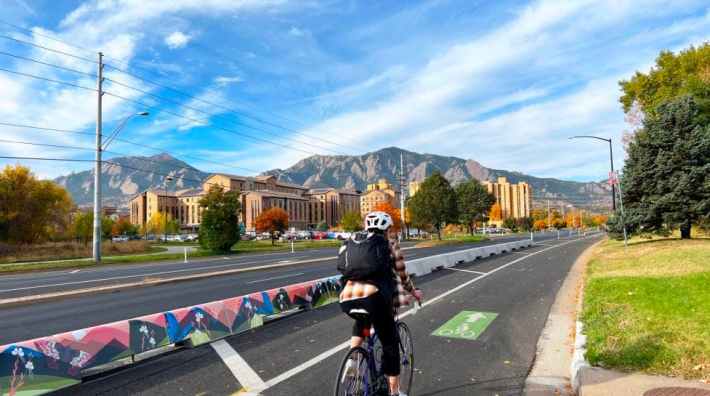
Inspired by successful implementations in cities like Toronto, Boulder introduced new “tall curbs” along Baseline Road in 2023 to physically separate bike and vehicle lanes, offering increased protection for people biking. The project is a critical element of Boulder’s Core Arterial Network (CAN), which includes plans for strategic improvements along some of the city’s least safe corridors for people walking and biking. With local artist Talia Swartz Parsell adding vibrant paintings to the barriers, the initiative combines safety and public art that complements the surrounding mountainous landscape. Further enhancements are slated for 2024, including additional bike lane barriers.
8. Pinellas Bayway South | Tierra Verda, Florida
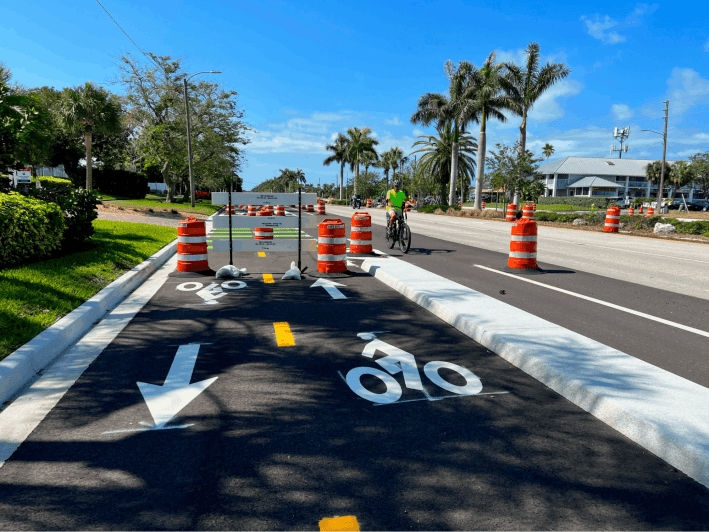
The Pinellas Bayway South Cycle Track in Tierra Verde is a significant addition to the more extensive Pinellas Trail network that spans more than 50 miles. Originating in 1983, the Pinellas Trail has steadily expanded since, becoming a regional destination with more than 1.5 million annual users. The new cycle track, separated from traffic by a raised concrete island, rectifies safety issues caused by vehicles parking in the prior non-protected bike lanes and helps reduce speeding along the corridor. Managed by the Florida Department of Transportation (FDOT) as part of a resurfacing project, the new cycle track closes a two-mile gap between the Pinellas Trail, connecting trail users to Fort De Soto County Park. “FDOT was able to use their existing standard detail for median islands to separate the cycle track from the travel lanes,” said Kyle Simpson, an active transportation planner with Forward Pinellas. “[That] reduced the cost of the project and did not require moving any drainage.”
9. East Main Street | Rochester, New York
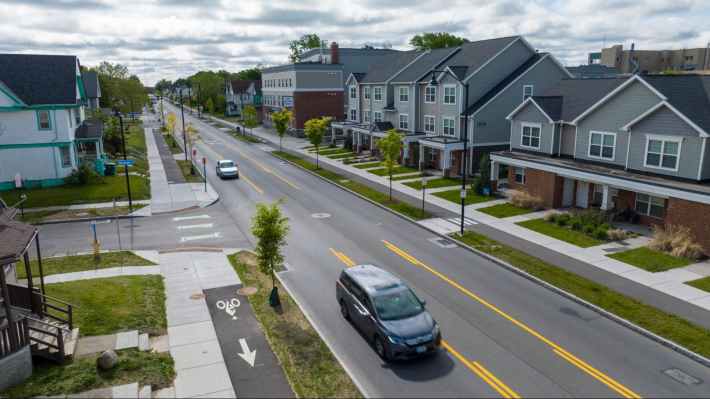
Rochester’s East Main Street Reconstruction project features sidewalk-level bicycle lanes designed in accordance with the City’s Complete Streets policy. While addressing needs such as roadway repaving, water main replacement, and new sidewalks, the project also introduced decorative lighting, street trees, and new signage. As part of Rochester’s “spine network,” a vital element outlined in the city’s Active Transportation Master Plan, the East Main Street project reinforces the city’s dedication to creating a well-connected and accessible bike network.
10. Avenue B | San Antonio
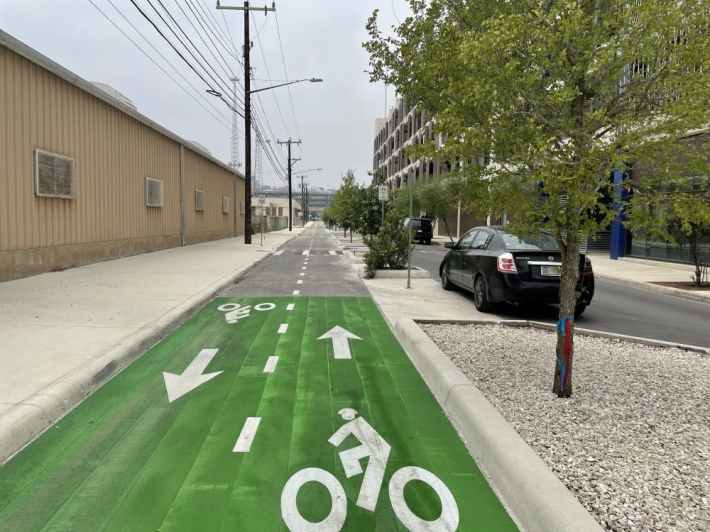
Through a $6 million Midtown Tax Increment Reinvestment Zone project, San Antonio transformed Avenue B into a one-way, southbound street to accommodate protected bike lanes, wider sidewalks, on-street parking, and landscaping. Serving as a vital connection between the River Walk, Downtown, and various amenities, Avenue B contributes to San Antonio’s expanding network of bike lanes and links to trails along the San Antonio River. Ultimately, the city hopes to extend the bike lane north of I-35 to reach the Witte Museum and Brackenridge Park.
11. Salem Avenue | Dayton
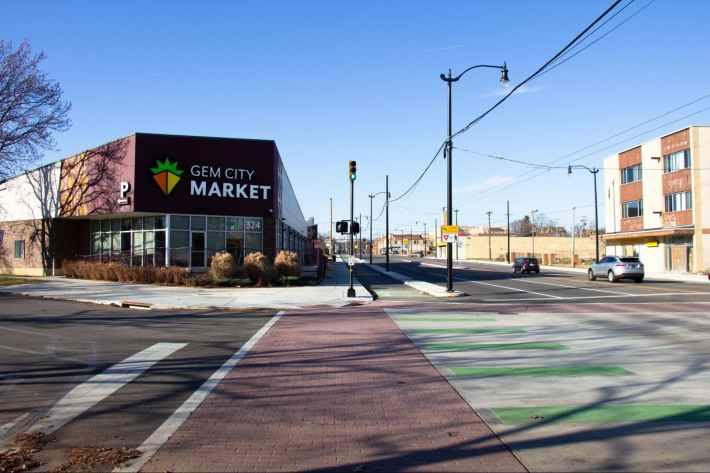
In a commitment to enhance road safety, the City of Dayton completed a $12 million reconstruction project along Salem Avenue between the Great Miami River and Cornell Drive. The federally funded initiative transformed a six-lane “stroad” into a lower-speed street with widened sidewalks, a bi-directional protected cycle track, decorative lighting, and pedestrian islands. The Salem Avenue project connects to more than 350 miles of regional trails as part of the Miami Valley Trails network. In September, Dayton approved an Active Transportation Plan to expand the network further, with more than 20 projects slated for construction by 2027.
12. 12th Avenue South | Nashville
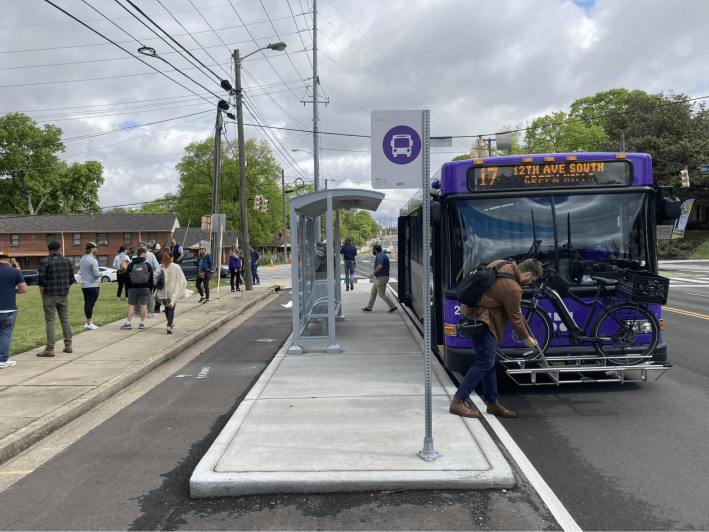
The 12th Avenue project in Nashville — envisioned as part of the 2017 WalknBike master planning process and subsequently identified as a top bikeway priority by the community — transformed a vital stretch of Nashville into the city’s first complete and green street. The 1.5-mile project includes physically protected bike lanes, bioswales for stormwater management, bus boarding islands, and safer pedestrian crossings.
“The corridor had existing, substandard bikeways — with significant demand for better, safer facilities to connect affordable housing and student housing with Nashville’s downtown and other commercial districts,” said Anna Dearman, NDOT’s walking and biking manager. In response, NDOT moved the project swiftly from conceptualization to reality, with accelerated final design and construction phases to improve connectivity for affordable and student housing residents along the corridor to downtown and other commercial districts.
13. Turner Avenue | Grand Rapids, Michigan
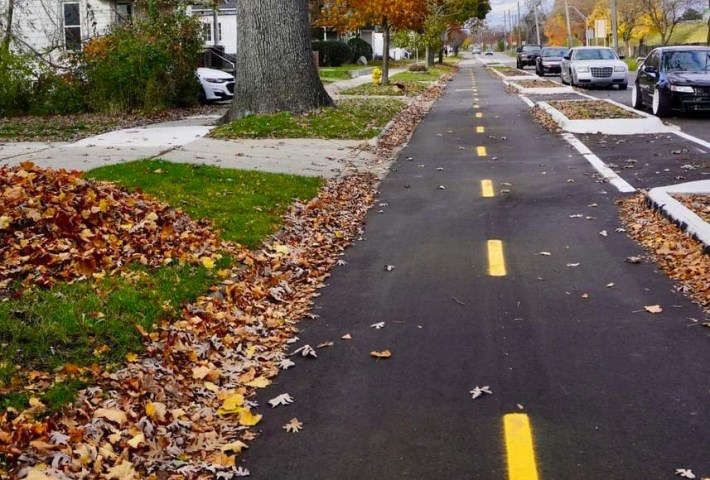
With funding from a combination of the city’s Vital Streets program (a voter-approved income tax for road and sidewalk projects) and federal Surface Transportation Program and Carbon Reduction Program sources, Turner Avenue represents a major bike infrastructure upgrade for Grand Rapids. This transformative project, which replaced a striped one-way bike lane with a new, separated, two-way facility, spans 1.2 miles from 4th Street to Richmond. The project also increased greenspace to mitigate stormwater runoff and filter pollutants entering the Grand River. The city plans to begin design work to extend the bikeway from 4th Street to Fulton Street West in 2024.
14. Martin Luther King Jr. Drive | Atlanta
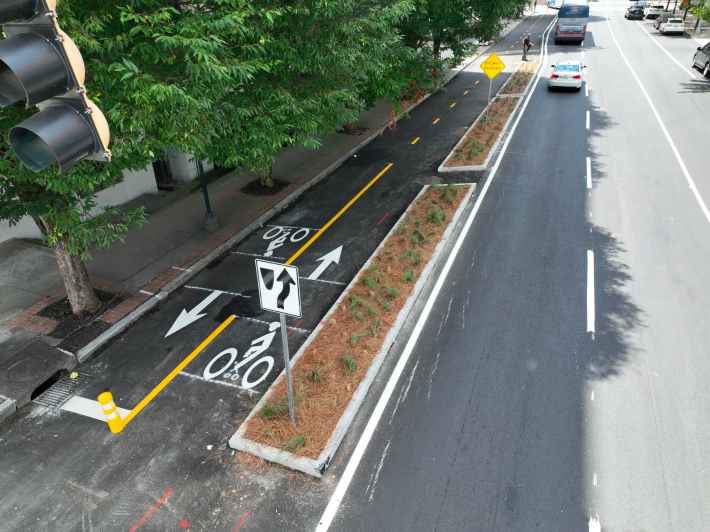
The Martin Luther King Jr. Drive Cycle Track in Downtown Atlanta was a collaboration between the City of Atlanta Department of Transportation and the Atlanta Downtown Improvement District, furthering the Downtown Atlanta Master Plan by enhancing safety and accessibility in the city center. According to Stacy Grolimund, senior project manager with Central Atlanta Progress and the Atlanta Downtown Improvement District, the project began in late 2022 when the Atlanta City Council voted to resurface streets near City Hall and the State Capitol. Councilmember Jason Dozier advocated for the inclusion of multimodal safety enhancements to align the project with the City’s Vision Zero goals. For now, the protected two-way cycle track stretches from Forsyth Street to Capitol Avenue, but the project is part of a more extensive planned network that will ultimately provide direct access to State Farm Arena, Mercedes-Benz Stadium, Georgia World Congress Center, and westside neighborhoods like Vine City.
15. Main Street | Agawam, Massachusetts
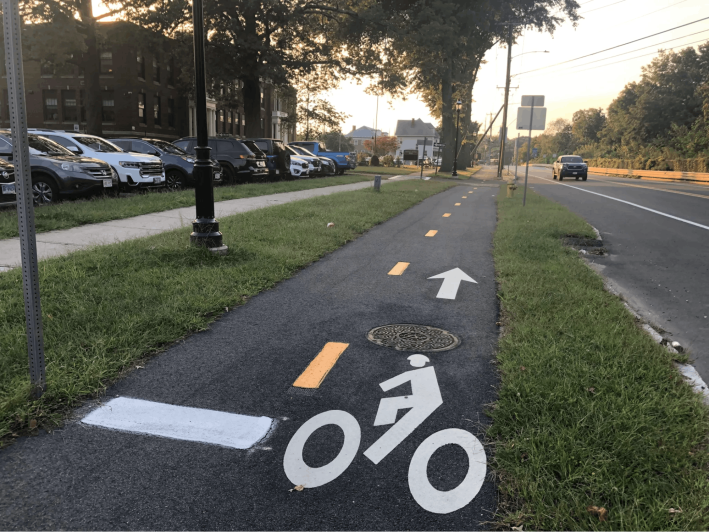
Physically separated bike lanes in the suburbs? Yes, please! In Agawam, Massachusetts, Dutch-style bike infrastructure emerged as one of the standout bike lanes of 2023. Sparked by the Morgan-Sullivan Bridge replacement and MassDOT’s Complete Streets directive, the project resulted in separated bike paths along Main Street, Springfield Street, Suffield Street, and Memorial Avenue. The area, dotted with strip malls, now offers improved accessibility to local businesses and schools, marking a significant step toward sustainable transportation for this suburban area. Since completion, it’s proven highly successful, with increased student biking and plans for further extensions to expand the network. Michelle Chase, Agawam’s town engineer, emphasized, “MassDOT’s Complete Streets program has been absolutely critical for the success of this project,” noting that it “inspired everyone involved in the design to push for the best accommodations even when challenges were encountered.”
16. 17th Street | Santa Monica
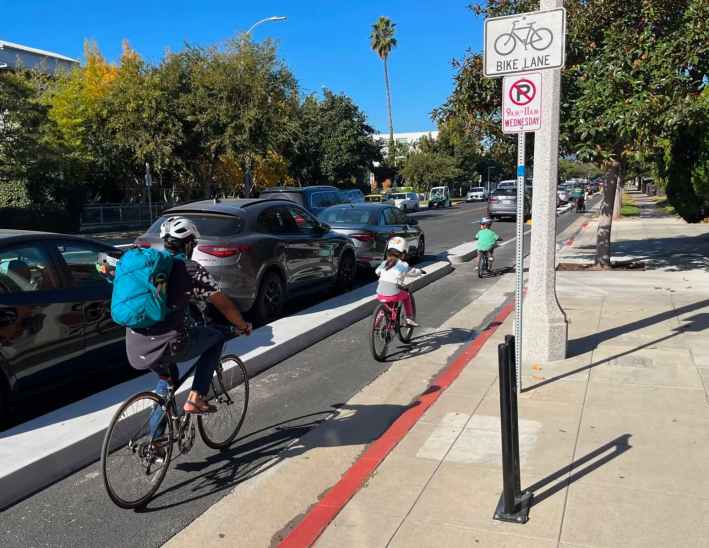
Santa Monica further solidified its reputation as a great city for bicycling with the completion of curb-protected bike lanes along 17th Street. Stretching just over a mile from Wilshire Boulevard to Pico Boulevard, this project features Southern California’s first curb-protected intersections, offering significant safety improvements for cyclists. The 17th Street bikeway conveniently connects key locations such as the 17th Street Metro E Line Station, Santa Monica College, and the Michigan Avenue Greenway, creating a more accessible and interconnected bike network.
Earlier in 2023, Santa Monica’s innovative use of a concrete extrusion machine for bike lane construction garnered significant attention, with the efficient, precise technology creating multiple blocks of protected bikeways in a single day. In a Streetsblog article from June, the city’s principal engineer, Selim Eren, highlighted the sustainability, cost-effectiveness, and speed of the method, emphasizing the significant transformation from traditional bike lanes to the new protected design on Ocean Avenue, resulting in a substantial increase in cyclist volume.
17. Meadowbrook Road | Jackson, Mississippi
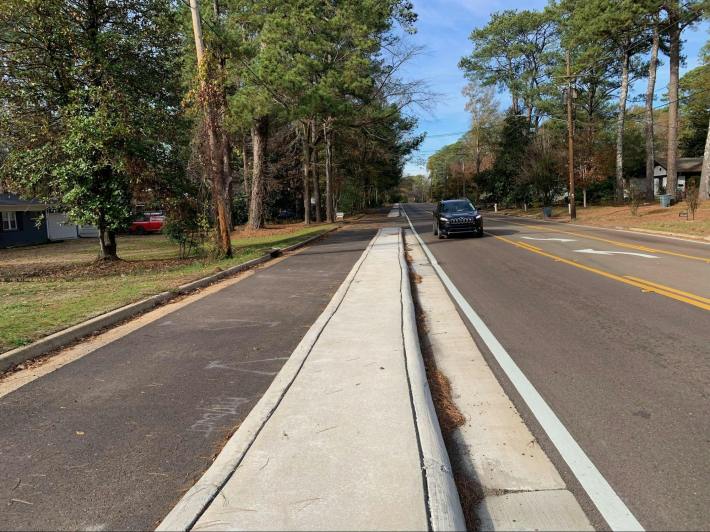
Jackson’s new Meadowbrook Road project, unveiled in May 2023, has been championed by the Mississippi Department of Health for its role in improving public health and well-being. From Old Canton Road to West Street/Northbrook Drive, the $3.3 million project features a new road-adjacent shared-use path for people walking, rolling, and biking. Funded through a federal FAST Act grant and Jackson’s One-Percent Municipal Sales Tax, the project also included roadway resurfacing, ADA modifications, and traffic signal upgrades. Meadowbrook Road is one of several projects the city has underway to connect its downtown to the Fondren District and Jackson State University. “In our community, our residents value both cycling and walking along with accommodating wheelchair users. With a smaller right-of-way in the heart of the city and the need to use our limited space efficiently, the shared-use path has become our go-to choice in the city,” said Robert Lee, Jackon’s city engineer.
18. Belmont Avenue | Chicago

Stretching approximately 1.25 miles, the recently constructed Belmont Avenue protected bike lanes create a low-stress, east-west route across Chicago’s Kennedy Expressway and over the Chicago River while connecting several north-south protected lanes, neighborhood greenways, the Chicago Transit Authority (CTA) Belmont Station, and the 312 Riverrun Bike Trail. The project also improved safety for pedestrians and transit riders through curb bump-outs, concrete refuge islands, and bus priority treatments.
The project marks just one of the dozens recently completed by Chicago — contributing to more than 55 miles of bikeway projects completed in the last year alone along streets like Augusta, Central Park Avenue in Garfield Park, Clinton, Dearborn, Grand, Kedzie, and Milwaukee. Together, these projects are signs of definite improvement for Chicago, which scored only 7 out of 100 points in our 2023 City Ratings. We’ll be watching closely to see how the city’s score improves in the coming years with its new commitment to protected bike lanes.
19. West Marginal Way SW | Seattle
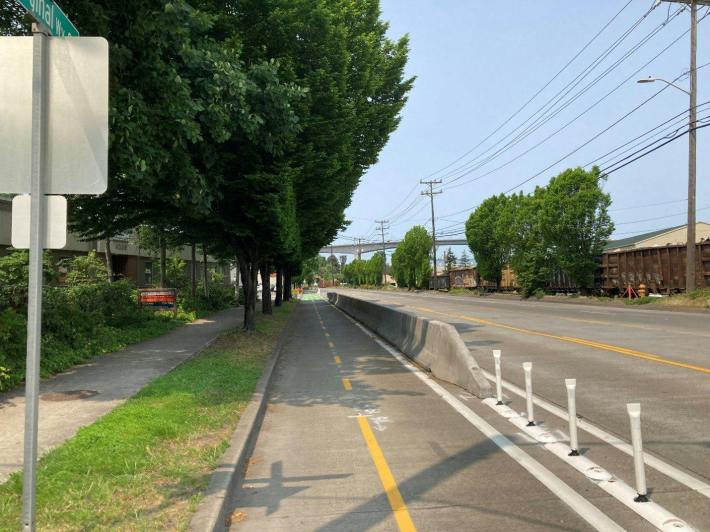
Seattle’s new protected bike lane on West Marginal Way SW, linking the Duwamish Trail to the West Seattle Bridge Trail, led to a 144% increase in weekday biking and more than a 90% increase in people walking. Despite initial concerns from some community members about traffic impacts, the city saw only a one-second increase in drivers’ travel time. Initially conceived during the West Seattle Bridge closure in 2020, the trail connection was solidified this year by adding concrete jersey barriers, ensuring a lasting, safe separation between the bike lane and vehicular traffic.
20. North Manhattan Avenue | Manhattan, Kansas
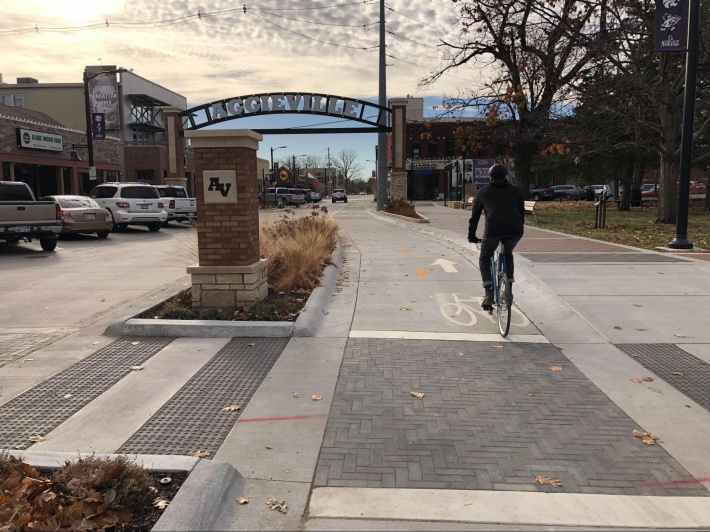
The North Manhattan Avenue project in Manhattan, Kansas, originated from a need to improve bike infrastructure between Kansas State University and Aggieville. In 1998, the city implemented one of the state’s first road diets on this corridor, reducing vehicular lanes and introducing standard bike lanes. Over time, it became clear that greater protection was needed for cyclists. In 2016, the Flint Hills Metropolitan Planning Organization proposed a two-way protected bike lane, which BikeWalkMHK championed. The project was ultimately funded by the Aggieville Tax Increment Finance district and a voter-approved Economic Recovery and Relief sales tax.
The post Two Massachusetts Projects Rank Among ‘America’s Best New Bike Lanes’ appeared first on Streetsblog Massachusetts.
